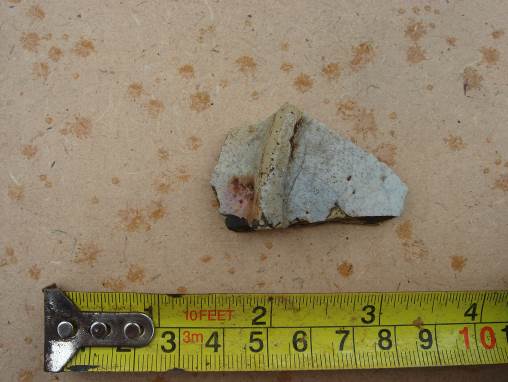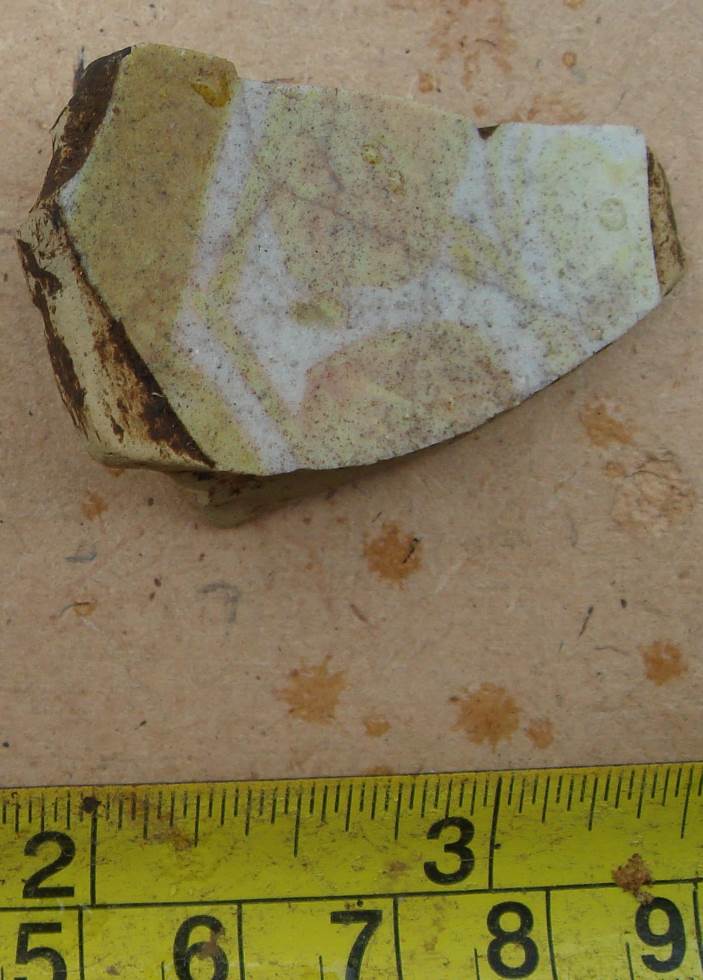The total weight of ancient ceramics (probably all from the 8th-9th centuries) was 4481 g. The total number of sherds was 643. Of this quantity, Chinese sherds numbered 136 (21%) and weighed 1485 g (33%). Local earthenware constituted 507 sherds (79%) or 2996 g (67%).1
One of the few Southeast Asian sites where Tang ceramics have been found and reported in detail is Prei Monti, 15 km east of Angkor, Cambodia (Pottier, Desbat, Dupoizat, and Bolle 2012). This site is believed to have been the location of a royal capital in the ninth century. In phase 2 of the site, imported (Chinese and Near Eastern) wares constituted 17% of the total ceramics recovered, in terms of number of sherds. The majority of the Chinese wares were white bowls with broad flat bi bases from Hebei and Henan, similar to bowls found on the Belitung shipwreck, and also at Siraf, a Persian port of the ninth century. About 8% of the imported sherds belonged to approximately 11 objects (bowls and kendis) made of stoneware from Changsha. Yue ware was rare in the Prei Monti excavation, only three pieces having been identified (Pottier et al: 302). It is possible that this rarity signifies a date in the early ninth century, before large-scale export of Yue ware began (Pottier et al 2012: 304), but this situation may be due to a Khmer preference for white porcelain over green. Three-colour ware comprised another 5% of the imported sherds, or approximately 5 vessels. The other Chinese imported ceramics were large olive- green-glazed jars, bowls, and basins from Guangdong. Similar bowls have been found in central Java, including one which was used as a container for a ritual deposit in Candi Sewu (Dupoizat 2006). One of the areas excavated at Prei Monti contained a particular concentration of sherds of this type of ware, suggesting that they were used for some specific purpose (Pottier et al 2012: 303).The Near Eastern wares were turquoise blue fritwares comprising 103 sherds (about 12% of all imported ceramics) which represent a minimum of 5 vessels.
When the Dieng Plateau temples were built, Chinese were not yet voyaging to Southeast Asia, and the ceramic export trade had not yet been established. Tang Dynasty ceramics are mainly found around the Straits of Melaka with a few as far west as India and Sri Lanka (Miksic 2009: 72-73). This proportion of foreign ceramics in a highland site far from the coastal ports or other ceremonial sites, probably inhabited only at certain times of the year, mainly by priests and pilgrims, is surprisingly high. It is probably that the imported ceramics were used in ceremonies, but they were not the most highly prized items. The most important ritual utensils were probably made of gold; examples have been found at the Wonoboyo site near Prambanan (Tim Jurusan Arkeologi 1991; Wahyono 1994, 1995).
The totals of reconstructed pieces in the above tables demonstrate that the bowls and jars were the most common shapes recovered. Kendis, vessels for drinking water, were used both in daily life and in rituals. Kitchen ceramics were present but not in large numbers, suggesting that little cooking or food preparation was conducted on the plateau.
It is difficult to determine the representativeness of this sample. The area of the football field is the western edge of what was once a much larger area of higher ground at the edge of the plateau. The plateau’s lower level was probably drained by the Aswatama system in the 8th century, so the area of Dharmasala might have been habitable. Perhaps more remains will be unearthed there someday if the problem of flooding can be overcome. The football field may have represented a marginal area, much of which may have been removed in recent years by the mining of soil to fill in the lower area. On the other hand, the central area may have been reserved for ritual activity, and the foot of the surrounding hills may have been set aside for habitation, along with the Dharmasala region at the northwest corner of the plateau. We just do not know at this point.
The discovery of a sherd of probably Persian lustreware was not expected, but it is not unprecedented. Similar fritware has been found in Palembang and Barus, Sumatra. This is however the first ancient sherd of Persian ware reported from any site in Java, as far as the authors of this report are aware. This discovery adds further detail to the historical sources from southwest Asia which begin to provide some details about Indonesia in the 9th century (e.g. Wheatley 1961: 210-251).
C. Ceramics.
LUSTRE WARE
On June 5, an unusual sherd was unearthed. It formed the base of a medium-sized bowl (TP2.2, spit 3). It was covered with a watery ivory yellow glaze. The body of this sherd is quite different from any known Chinese type; it comprises a fine smooth material, dull yellow in colour, much softer than Chinese glazed stoneware. It was clearly distinct from the white-bodied lead-glazed earthenware found in other units of this excavation. Faint hints of a possible rose and green coloured underglaze design could be discerned.
Photographs of this sherd were sent to Dr. Yolande Crowe, who confirmed the excavators’ preliminary suspicion that this sherd is lustreware from the Persian Gulf (Yolande Crowe, personal communication, 10 January 2012).2 Lustreware has been reported from Palembang and Lubuk Tua in Sumatra, both of which date from approximately the same period as the Dieng Plateau site. This find augments the evidence provided by the Chinese ceramics that Dieng, despite its location in a remote hinterland volcanic crater, was linked to the trade route between Indonesia and China and the western Indian Ocean in the ninth century.
CHINESE CERAMICS
Despite a long series of surveys and temple restorations, no ceramic discoveries were ever recorded from the Dieng plateau until the 2010 excavation, which was specifically designed to recover information about this type of material. In 1983, Miksic observed and photographed Chinese ceramics of the ninth century and local earthenware exposed on the surface of a footpath enabling visitors to cross the swampy ground between the Arjuna complex and the paved road west of Candi Gatotkaca. Similar sherds were observed in a profile near Candi Gatotkaca created by the quarrying of soil to construct the footpath. The base of a Changsha three-colored bowl was also found in a ditch east of the Arjuna complex. These finds gave rise to the suspicion that deposits of these ceramics should still be found in situ on the plateau. The recovery of such sherds would shed the first rays of light on the types of activities conducted on the plateau in the Early Mataram period, to supplement the information garnered from the sculptures, architecture, and inscriptions.
The 2010 excavation did not succeed in identifying the precise location of the exposed profile observed in 1983. More soil had been removed from the area between Candi Gatotkaca and the football field to the north. The excavation did however succeed in discovering a range of ninth-century sherds in situ, including local earthenware and imported sherds. All imported sherds came from China with the exception of one sherd which probably came from the Persian Gulf.
The Chinese sherds from the 2010 Dieng excavation belonged to well-known types: fragments of large jars with yellowish-green glaze probably made in Guangdong province and conventionally termed Dusun jars because of their ancient popularity among the Dusun people of Kalimantan; green Yue ware probably made in Zhejiang and Fujian; three-coloured ware made near Changsha in Hunan; white Ding or Ding-type ware from northern China; and green-splashed ware.
Changsha Ware: 6 sherds.
- A’a10.8 spit 4 no 2
- A’a 11.1 spit 4 foot of bowl
- A’e 11.3 spit 3 lip of a bowl/plate; photos DSCF3478, 3480
- Ae11.3 Spit 5 No 3 DSCF 3488
- TP2 Spit 3 No 2
- TP2.1 spit 4 no 23
Green splashed ware: 1 sherd
- TP2 spit 3 no 3
Yue ware: 7 sherds
- A’e 11.3 spit 2 bowl body; photos DSCF3462, 3463; TP2.1 spit 4 no 23
- TP1 Spit 1 No 1 (photo 21)
- Spur-marked bowl base: TP1.3 3 no. 1
- TP2 Spit 4 No 26; spit 5 no 34
- TP2.1 spit 4 no 25
- A’c11.3 Spit 2 No 2 Photos DSCF3592, 3594; spit 4 no 49
- A’e11.3 Spit 2 No 1 Photos 77, DSCF3462, 3463
White porcelain: 12 sherds
- TP1 Spit 3 No 2 (Photo 23)
- TP1.2 spit 1 no 1
- TP1.2 spit 3
- TP1.3 spit 3 no. 19, 20
- TP2.1 Spit 4 No 24 DSCF3252
- TP2.2 spit 1 no 1
- A’c11.3 spit 2 no. 19
- A’c11.3 spit 2 no 2
- A’c11.3 spit 2 no 19
- A’C11.3 spit 4 no 54
- TP2.1 Spit 3 No 12
- A’c11.3 Spit 2 No 19
Dusun ware: 9 sherds
- TP1 Spit 3 No 1
- TP1.1 Spit 3 No 1
- TP1.1 Spit 4 no 2
- TP1.1 Spit 4 no 4
- TP 1.2 Spit 3 Nos 3, 4, 5
- TP1.4 Spit 3 No 2
- TP2 Spit 3 No 1
- TP2.2 Spit 4 Nos 64, 65
- A’c11.3 Spit 2 Nos 9, 10
Green Lead Glaze: 8 sherds, all probably from the same object
- TP2.2 spit 3 nos. 26-34
1.Four sherds of earthenware have been provisionally identified as “foreign”: TP1.2 spit 3 no 28 (with pyrite); TP1.3 spit 4 nos. 1 and 2: 3 sherds, total weight 7 g. Their precise origin is unknown.
2.Dr. Crowe’s assistance is gratefully acknowledged.

